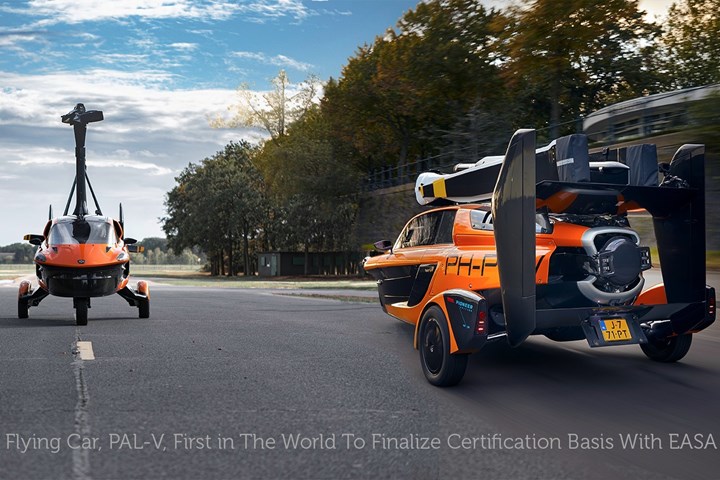PAL-V and EASA finalize first flying car certification
After 10 years of testing, the Dutch company completes full certification basis with EU’s aviation regulator and opens path to commercialization.

Photo Credit: PAL-V
PAL-V (Personal Air Landing Vehicle, Raamdonksveer, Netherlands), a Dutch company involved in the development of a commercial flying car, announced on Feb. 23 that in addition to being the first flying car — a combination of car and gyroplane — to get road permission for Europe, its composites-intensive PAL-V Liberty (see “GKN Fokker to advise design, manufacture of PAL-V flying cars”) is now reportedly the first to complete the full certification basis with the European Union Aviation Safety Agency (EASA).
Based on PAL-V's 10 years of test results, EASA specialist teams finalized the requirements for the PAL-V Liberty. PAL-V says the issuance, after industry consultation, shows the confidence of the European authorities and the maturity of its design and company. The final phase is compliance demonstration.
“Getting a flying car to the market is hard. It takes at least 10 years,” says Robert Dingemanse, PAL-V's CEO. “Although we are experienced entrepreneurs, we learned that in aviation everything is exponentially stricter. Next to the aircraft, all aspects of the organization, including suppliers and maintenance parties must be certified.”
In 2009 PAL-V says it agreed with the EASA to use the Certification Specifications for Small Rotorcraft, CS-27, as a starting point for the development of the Certification Basis. Since then, PAL-V has worked together with EASA to amend the complete list of more than 1,500 criteria to make it applicable for the PAL-V. The list was published last year for review by industry experts and the final version was published the week of Feb. 15, 2021.
“Safety is key in developing the Liberty,” says Mike Stekelenburg, CTO. “We are privileged to work with top experts of the EASA. Their high safety standards also allow Liberty to be used professionally. From the start, we built the flying car to comply with existing regulations. This strategy provides the fastest route to market.”
According to PAL-V Head of Airworthiness, Cees Borsboom, “It's hard to grasp the amount of work required to certify an aircraft. More than 10 years of analysis, test data, flight tests and drive tests have led to this important milestone. In parallel, we already started compliance demonstration to obtain the Type Certificate, which will be followed by delivery of vehicles to our customers."
The EASA Type Certificate (TC) is valid for Europe and is also accepted in 80% of the world market, including the U.S. and China.














.jpg;maxWidth=300;quality=90)

